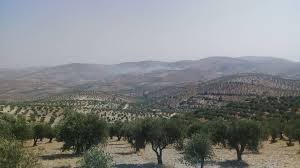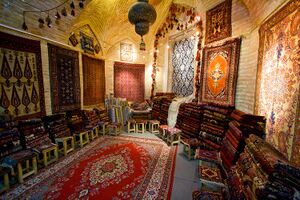Mansuriyyah
Mansuriyyah is a nation located in the continent of Siduri in Tyran. It borders Ruvelka on the North, Allamunika on the East, and Mubata on the South
History
Prehistory and early history
Al-Bashiri Caliphate
Rawwadid Dynasty
Arkoennite Occupation
Formation of Modern Mansuri State
Government and Politics
Mansuriyyah is often considered a theocracy by international analysts, but the label is often dismissed by the country’s officials. Following the establishment of the country in the 19th century, a new political system was created based mostly on modern political theory as well as Islamic governmental jurisprudence. An Amir (leader), who is both the Head of State and Government, rules the country. He is chosen by the Shura Council, a body that also acts as a consultative and regulatory body for the Amir. The country is divided in a number of Provinces, administered by governors appointed by the Amir. Each province is further divided into several districts, administered by elected officials.
A lower chamber was added to the Majlis Al-Shura in 2013’s wide-ranging political reforms, consisting of elected officials from every Mansuri Province. The liberalizing reforms aimed at giving the people more voice and participation in the government also ceded more power to provincial governors.
Geography
Located in Western Siduri, Mansuriyyah host a wide range of different climates and topography. The West has a humid Mediterranean climate, becoming increasingly arid towards the interior. The North is mostly mountainous with temperate climate, transitioning into a continental climate towards the Northeast.
Climate
Western Mansuriyyah's weather is mostly of the Mediterranean type with an average rainfall of over 1,000 millimeters near the coast and on Qartaba mountains' western slope. It becomes increasingly drier east of the mountains, where rainfall average drops to 250mm. Weather is milder and rain more abundant along the coastal plains and the Juwayiq gulf.
Northern Mansuriyyah is broadly divided in two weather areas with the western part shows typical characteristics of Mediterranean climate, while the more mountainous areas are affected by Continental climate. The region has very hot and dry summers and cold and often snowy winters. Weather is drier along the Azraq river valley.
The Northeast is rugged country with higher elevations, a more severe climate, and greater precipitation than on the North. Due the distance from the sea and high altitude it has a harsh continental climate with long winters and short summers. During the winter, it is very cold and snowy, during summer the weather is cool in the highlands and warm in the lowlands. The region has the lowest average temperature of all Mansuri regions, with -25 °C. Although it can get below -40 °C. The summer average is about 20 °C.
To the East, the Barad mountains experience lower temperatures, severe winters with below zero average daily temperatures and heavy snowfall. The eastern and central basins are arid, with less than 250mm of rain, and have occasional deserts.
Topography
Water
With large swathes of Mansuri territory being semi-arid steppes or desert, water sources are of vital importance. The main rivers are the Shabb, running on the South and marking most of the border with Mubata, while the Azraq river, born from the Jibal al-Barad, and crisscrossing Mansuriyyah from the Southeast until the Northwest, where it flows into the Juwayqi Gulf. A number of smaller watercourses flow down from the Matras mountains into the Azraq basin. A number of lakes exist in the Qafqaz highlands in the Northeast. The arid deserts of central Mansuriyyah contain a number of oases but lack permanent water courses, as the few rivers that flow eastward from the Qartaba mountains empty into small swamps and lakes in the semi-arid plateaus of Badiyat al-Hawram. Eastern Mansuriyyah lack any major river, but a number of minor rivers and streams flow eastward from the Barad mountains.
Fauna and Flora
Demographics
Peoples
Mansuriyyah has an ethnically diverse population. It is a majority-minority country, in which no ethnic group forms a majority by itself. Most of the population is concentrated in a broad arch encompassing the coastal areas, fertile northern plains along the Azraq River basin, and industrialized areas on the eastern slopes of the Barad mountains. The country's easternmost regions as well as the central area are largely depopulated deserts, save for some nomadic populations and small settlements on oases.
The main ethnic group are Arabs, which predominate in the Western and central regions of Mansuriyyah, and comprise some 40% of the total population. They're followed by Persians, which occupy the Eastern provinces and total almost 25% of the population. The third major ethnic group are the Kurds, which predominate in the northeast but are also found throughout the north and along the Barad mountains. Chechens are just some 5% of the total population but are the majority in the Qafqaz province in the northeast, but also can be found in scattered villages in the West. Another 5% of the Mansuri population are Turkic, which aren't the majority in any province, but can be found in large numbers in the Northwest and Northeast. Another native group to Mansuriyyah are the Kan'ani, which in the classical time used to populate the Western and Northern regions, but were assimilated to the dominant Arab culture following the spread of Islam. They comprise almost 5% of the population, almost all of them adhering to Christianity. Mubatan peoples can be found along the border, most of them intermixed with local Arabs.
Languages
Arabic is the official national language, as well as the lingua franca among different ethnic groups. It's spoken by over 90% of the population, and is the native language of some 40%. Persian, Kurdish and Chechen are recognized as official regional languages. A number of minority languages share a special, recognized status in districts with large number of native speakers, or due to their cultural or religious significance.
All languages (besides Arabic) are written using a modified Arabic script, with the exception of Kan'ani and Hebrew, which use their own scripts.
Religion
Islam is the most followed religion in Mansuriyyah, with 86% of the population declaring themselves Muslim. Next is Christianity, with roughly 10%, followed by Judaism, with 4%. Other religions aren't officially recognized, and are usually followed by expats.
Religion plays a central role in the lives of many Mansuris. Religious commitment researches show that 92% of Mansuris say religion is very important in their lives. The most prevalent madhab (school of law) is the Shafii, closely followed by the Hanafi. Maliki and Hanbali followers are limited to pockets scattered across the country. The practice of Sufism is also very popular. Some 18% are formally associated with a Sufi brotherhood, but the number of those informally connected is much higher. Sufi ethos is deeply ingrained in Mansuri culture. The Naqshbandi brotherhood has the most number of formal followers, distributed along a number of derivative branches, and had fundamental participation in the building of the modern Mansuri state.
Population Centers
Economy
Mansuriyyah has a well-developed industrial economy, and is considered a capitalist mixed economy. The country is among Tyran’s leading producers of textiles, motor vehicles, chemicals, construction materials, machinery and machine tools, electronics and home appliances. Oil, natural gas and fuels also play a pivoting role in Mansuri economy, contributing to 12% of the GDP, while also being an emerging knowledge economy. Since the 1990s some Mansuri companies have gained multinational status, often expanding their activities in culturally close nations. Economy reforms in the 80s brought in a new wave of foreign investment, fueled by a strong export policy and a qualified yet inexpensive work force.
Agriculture
Mansuriyyah is a leading producer of olives, dates, hazelnuts, almonds, citrus fruit, cotton and spices. Agriculture contributes 10% to the GDP and employs 16% of the labor force. The main crop-producing areas along Shabb and Azraq rivers, coastal plains and valleys on the Barad Mountains. Most land is privately owned, and agricultural cooperatives are common, while large scale farms are dedicated to cash crops such as cotton, and more commonly found along the major rivers.
Agriculture is highly dependent on irrigation, of which the government makes massive investments. Construction of multipurpose dams and reservoirs along rivers in mountainous areas have increased the amount of water available for irrigation. Most irrigated land is designated "strategic", meaning that it encounters significant state intervention in terms of pricing, subsidies, and marketing controls.
Livestock is common in steppe and mountainous areas, and especially prevalent in the northeastern highlands. Lamb and sheep are the most commonly raised animals. Horses are traditionally raised in some regions, especially in central and eastern Mansuriyyah, and constitute a niche market for riding and racing animals. Pork is absent due to religious grounds.
Forestry is strictly controlled by the government, which also runs a reforestation program. Limited forestry activity is centered in the higher elevations of the mountains just inland from the coast, where rainfall is more abundant.
Industry
Mansuriyyah boasts a large and diversified industrial sector, greatly expanded during the oil boom during the early XX century. Since the 90s, oil revenues are being invested in the technology sector through the “Oil for Microchips” program, with the establishment of the Silicon Wadi, a few kilometers south of the capital Al-Jadidah, and the founding of the Mansuri Institute of Technology. Despite these investments, the main industrial sectors are oil refining, petrochemical products, textiles, machine industry and automotive industry. Other important sectors are food processing, defense, consumer products, electronics, mining and steel. Most industries are small and medium-sized businesses. Industries in the oil and mining sectors are heavily regulated.
Textile production in Mansuriyyah dates back to the 10th millennium BCE, and much of the output of the nation’s weavers has rightly been hailed as masterworks. The first Eracuran-style factories were established in the 1820s and were among the first establishments in the country to use modern technology. Textile production continued to play an important role in the economy despite the raise of oil industry in the early 1900’s, benefiting from government investments, cheap domestically produced wool, cotton and silk, as well as a trained workforce.
Service
Oil
Culture
Birthplace of Abrahamic religions, Mansuriyyah has historically been a bastion of social conservatism in Tyran. The country is often criticized by socially progressive think-tanks for its policies regarding gender equality and sexuality. Most Mansuris however, regardless of religious affiliation, uphold traditional, conservative social policies. A 2016 research by XXX university showed that this mentality is prevalent even amongst Mansuris living abroad, even though these tended to hold more open views than his mainland counterparts: 69% of expat Mansuris consider themselves socially conservative, compared to 98% among mainland nationals.
Religion plays an important role in all aspects of life. Daily routine is based around the five daily prayers, when most businesses close as people go to prayer rooms and mosques to offer the prayers in congregation. Religious celebrations mark the national holidays, of which the most import are the festivals at the end of Ramadan and peregrination. The Mawlid Al-Nabi, the festival celebrating the birth of Prophet Muhammad also takes special place, with great public celebrations. Other important holidays are the day of Ashura, Laylat Al-Miraj, Laylat Al-Miraj, Laylat Al-Qadr and the day of Arafah. Religious minorities are assured the right to celebrate their particular holidays.
Family Life
The family is the heart of Mansuri social life. Frequent visits and exchanges of invitations for meals among family members are integral to daily living as well as family outings to favourite picnic spots by streams or to mountain resorts. Families tend to live close by, even in big urban centers, often sharing the same building. Contrary to a popular misconception, most marriages are monogamic, with only 6% of households being polygamic.




